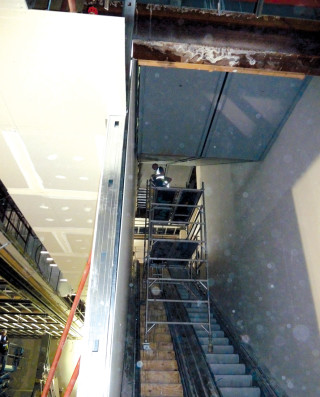The first instinct of any business facing a prosecution for safety failings is to call in the lawyers, swear everybody to secrecy, pull up the drawbridge and start planning a damage-limitation strategy. But when Teesside shopfitting contractor Newman Scott found itself facing prosecution by the HSE in 2013, its response was radically different.
“We could try and limit our exposure to prosecution, involve our lawyers and limit the flow of information - or we could set about a full, open and frank internal investigation to ascertain the root causes and put in place measures to prevent a re- occurrence,” says joint managing director John Graham. “We did not think the former was the right or moral thing to do and we felt it would interfere with our goal of actually making things safer for people on our sites.”
In July 2013, Newman Scott started a 17-week contract to strip out and refurbish the four-storey Manchester Arndale Centre branch of clothes retailer Zara UK.
On September 24th, two-thirds of the way through the contract, the site received a visit from HSE inspector Matt Greenly. It was a routine inspection; no accidents had happened. But what Greenly saw resulted in a notice of contravention and a prohibition notice. The prohibition notice related to a mobile scaffold tower erected by one of Newman Scott’s subcontractors, dry-lining specialist Ormesby Ltd, on the escalator linking the ground and first floors. The working platform was five metres above the ground but the scaffold had no edge protection, no toe-boards, was incorrectly assembled and inadequately secured. Nor was it designed for assembly on a staircase or escalator.

Elsewhere, Greenly spotted a decorator sanding plaster on a wall without the protection of a mask or respirator. Fine dust was visible around his nose and mouth. Dust and debris also littered the area and there was no hot water available on site. Graham was “mortified” that this could have happened: “We thought we were pretty good at health and safety,” he says.
Since 2000 the company, which started trading in 1995, has worked hard to train its staff and, over time, has introduced comprehensive formal safety systems. “We haven’t had a reportable accident on any of our sites,” says Graham. But he admits that Newman Scott has had occasional problems arising as the result of human error. Indeed, the company had previously received two prohibition notices, both relating to work-at-height breaches. But on both occasions it had followed up with thorough investigations and taken steps to improve its safety systems. With this third incident, Newman Scott immediately set about rectifying the situation. The tower was dismantled and a fixed scaffold erected; hot water was restored within 30 minutes; labourers were brought to site to clear the dust and debris and vacuum equipment hired in to reduce airborne dust. Ormesby’s site manager was replaced and the two operatives who had erected and used the scaffold were barred from site. Newman Scott’s health and safety auditor spent the next four weeks on site and other senior personnel – including Graham – also spent time on site. But Graham struggled to understand how his company, so conscientious about health and safety, could have blundered into this situation. He decided to conduct his own investigation and, crucially, resolved to cooperate with the HSE and keep the regulator fully informed. Within six weeks the company had completed its investigation and produced a detailed report. The 11-page document, which has been seen by TCI, is unflinching in its analysis and clearly outlines a combination of factors that undermined what were otherwise robust safety standards.
The subcontractor, Ormesby Ltd, was a long-standing supplier that had given sterling service over several years. But, unlike all the suppliers appointed since the introduction of new health and safety systems, Ormesby had never had to pre- qualify or demonstrate its understanding of the employer’s health and safety regime. The company’s owner, while highly experienced, had received no safety management training. Like all subcontractors, Ormesby had been required to submit a risk assessment method statement (RAMS) to Newman Scott. This proved to be a generic document that did not address site specifics. Nevertheless it was signed and placed in the site file. The extent of the works (if any) for the escalator well in which the offending scaffold was eventually erected was unknown at the time Ormesby arrived on site at the end of July. When finally it was decided, in mid- September, that the ceiling, and bulkhead walls in the escalator well were to be replaced, Ormesby’s generic RAMS, which specified the use of scaffold towers, was invoked.

The scaffold tower was erected by Ormesby’s site supervisor, who was PASMA- trained. But the unusual shape of the escalator well meant that there was no space for a guardrail, which was therefore omitted. The side-rails of the escalator also meant the scaffold could not be erected against the walls, requiring the operative to lean outside the working platform.

This was all clearly visible to HSE’s Matt Greenly when he visited the site. But what nobody knew until two days after the HSE inspection was that Newman Scott’s site agent, responsible for day-to-day management of the site, was experiencing symptoms of severe stress brought on by the amount of work he was being asked to undertake in order to achieve the original handover date. Design changes and substantial additional work were being required by the client without change to the completion date. The effects on the site agent were initially known only to his wife; they only manifested themselves on site when things came to a head following the HSE inspection. Then the site agent was sent home on sick leave. “We should have been more alive to the pressures he was under and the early audit reports themselves gave an indication because surprise was being recorded at the less than excellent ratings he normally achieves,” admits Graham.
The failures were not in Newman Scott’s methods or systems, but in a combination of human factors - in particular the failure of the project manager to implement and ensure compliance with the Construction Phase Plan as required under the CDM regulations and the failure of the site agent to supervise Ormesby’s work, question the RAMS and prevent unsafe work at height. “When we first started to roll out our investigation...to our workforce and sub- contractors, the reception was lukewarm,” notes Graham. “However, this all changed completely as soon as everyone found out that the company, the director and the site foreman were also facing potential criminal charges.” This revelation sent shockwaves through the workforce, he says.
The shock served as a catalyst for change, says Graham. “We altered our management structure, employed another full-time health and safety officer and implemented rigorous auditing procedures. “We focused on improving the already positive safety culture in the company through better communication, more training, more competency-checking and giving more ownership of health and safety to our employees,” he adds. Most important, says Graham, was the reinforcement of the unequivocal message that people would always have the support of the management team if they refused to do something that they felt was unsafe. Graham only instructed his lawyers after the summonses were served in May of this year. The company, the project manager and the subcontractor all appeared before Trafford Magistrates and all pleaded guilty to charges under the Health & Safety at Work Act 1974 and the Work at Height Regulations 2007.
Newman Scott was fined £9,599, its project manager £1,466, and Ormesby was fined £6,599. The site agent, suffering from stress, was not prosecuted; after a period of sick leave, he returned to work with reduced workload and responsibilities. Two employees (the project manager and a senior site foreman) who “didn’t embrace the change” left the company following the prosecution. “One of them was a director and a shareholder and because he was so high up, the workforce were getting mixed messages. He had to go,” says Graham. Ormesby was removed from Newman Scott’s list of qualified subcontractors and no contracts were engaged with the firm until it (along with all other ‘grandfather rights’ qualified suppliers) had undergone the appropriate training and passed Newman Scott’s prequalification process.
Much has changed at Newman Scott, and while Graham admits that some of this change might have happened anyway, he is convinced that the enforcement action “prompted a sea change in attitudes across the workforce at all levels”. One very significant change is the company’s perception of the HSE. Many contractors suspect that HSE inspectors are motivated by prosecution figures and collecting the controversial “fee for intervention”. But, says Graham “we found that, having made that decision [to cooperate] the inspector was incredibly helpful and understanding.
“We were treated with respect and courtesy [and] that assisted us to approach the experience in a positive way and maximise the health and safety improvements.” Graham admits that he cannot say there will be no lapses in the future: “We live in an imperfect world and mistakes happen,” he says. But despite the trauma of prosecution – not to mention the fines - he has no regrets. The whole process has cost the company in excess of £50,000. “We probably should have spent that before,” he says, “But I don’t regret it. I’d much rather spend it on a tough learning experience than on lawyers.”

This article first appeared in the October 2015 issue of The Construction Index magazine. To read the full magazine online, click here.
To receive you own hard copy each month in traditional paper format, you can subscribe at
http://www.theconstructionindex.co.uk/magazine
Got a story? Email news@theconstructionindex.co.uk



